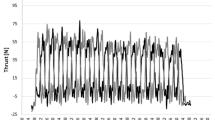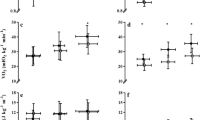Abstract
To test whether adding insulation to the arms would improve cold water swimming performance by delaying swimming failure (SF). Novice (n = 7) and expert (n = 8) swimmers, clothed and equipped with a personal flotation device, each performed two trials in a swimming flume filled with 10°C water. During free swimming (FS), subjects performed swimming until failure, followed by the Heat Escape Lessening Posture. In free swimming with additional insulation (FSA), subjects wore custom-fitted armbands. Trials ended when rectal temperature decreased to 34°C or after 2 h of immersion. Measurements included: rectal and skin temperatures, heat flow, and various appraisals of swimming performance. FSA was thermally advantageous versus FS. Rectal temperature cooling rates during swimming (dT/dt Swim) were faster for FS compared to FSA (0.050 ± 0.007°C min−1 vs. 0.042 ± 0.006°C min−1, P < 0.01). Armbands maintained arm skin temperature about 10°C warmer, for approximately 70 min (P < 0.001). Although additional insulation did not greatly improve physical performances, video analysis showed that swimming technique in FSA was maintained 10–15% better than in FS between minutes 30 and 50 (P < 0.001). SF was achieved in 5/30 trials, with increases in stroke rate (6.6 str min−1) and decreases in stroke length (0.24 m str−1) observed. In this simulation of cold water swimming survival, equipping subjects with neoprene armbands appears to have partially preserved muscle function, but with unimpressive effects on overall performance. SF is a complex entity, but is evidently related to both triceps skinfold and arm girth.







Similar content being viewed by others
References
Blomstrand E, Essen-Gustavsson B (1987) Influence of reduced muscle temperature on metabolism in type I and type II human muscle fibres during intensive exercise. Acta Physiol Scand 131:569–574
Costill DL, Lee G, D’Acquisto LJ (1987) Video-computer assisted analysis of swimming technique. J Swim Res 3:5–9
Costill D, Maglischo E, Richardson A (1992) Swimming. Blackwell Scientific Publications, Oxford
Dubois D, Dubois EF (1916) A formula to estimate the approximate surface area if height and weight be known. Arch Intern Med 17:863–871
Ferretti G, Veicsteinas A, Rennie DW (1988) Regional heat flows of resting and exercising men immersed in cool water. J Appl Physiol 64:1239–1248
Giesbrecht GG, Bristow GK (1992) A second postcooling afterdrop: more evidence for a convective mechanism. J Appl Physiol 73:1253–1258
Golden FS, Hardcastle P (1982) Swimming failure in cold water. In: Proceedings of the physiological society, pp 60–61
Hardy JD, Dubois EF (1938) The technic of measuring convection and radiation. J Nutr 15:461–475
Hayward JS, Eckerson JD, Collis ML (1975) Effect of behavioral variables on cooling rate of man in cold water. J Appl Physiol 38:1073–1077
Hayward JS, Eckerson JD, Kemna D (1984) Thermal and cardiovascular changes during three methods of resuscitation from mild hypothermia. Resuscitation 11:21–33
Hayward MG, Keatinge WR (1981) Roles of subcutaneous fat and thermoregulatory reflexes in determining ability to stabilize body temperature in water. J Physiol 320:229–251
Heus R, Hein AM, Havenith D, Havenith G (1995) Physiological criteria for functioning of hands in the cold. Appl Ergon 26:5–13
Horvath SM, Spurr GB, Hutt BK, Hamilton LH (1956) Metabolic cost of shivering. J Appl Physiol 8:595–602
Hoskin RW, Melinyshyn MJ, Romet TT, Goode RC (1986) Bath rewarming from immersion hypothermia. J Appl Physiol 61:1518–1522
Keatinge WR, Prys-Roberts C, Cooper KE, Honour AJ, Haight J (1969) Sudden failure of swimming in cold water. Br Med J 1:480–483
Kenny GP, Reardon FD, Ducharme MB (2001) Physiological limitation to emergency swimming in cold water. DCIEM Contract Report CR 2001-026
Lounsbury DS (2004) Swimming survival—performance and judgement in cold water. M.Sc. thesis, University of Toronto, Toronto, Canada, 462 p
Millet GP, Chollet D, Chalies S, Chatard JC (2002) Coordination in front crawl in elite triathletes and elite swimmers. Int J Sports Med 23:99–104
Noakes TD (2000) Exercise and the cold. Ergonomics 43:1461–1479
Nunneley SA, Wissler EH, Allan JR (1985) Immersion cooling: effect of clothing and skinfold thickness. Aviat Space Environ Med 56:1177–1182
Plyley MJ, Shephard RJ, Forsyth RD (1985) Development of protocols for accurate measurement of body composition. Contract OISE 97711-2-6886. Toronto, Defence and Civil Institute of Environmental Medicine
Sawasaki N, Iwase S, Mano T (2001) Effect of skin sympathetic response to local or systemic cold exposure on thermoregulatory functions in humans. Auton Neurosci 87:274–281
Siri WE (1956) The gross composition of the body. In: Advances in biological and medical physics, pp 239–280
Sweeney D, Ducharme MB, Cheung B (2005) Motion sickness accelerates the development of hypothermia during exposure to cold. In: Holmer I, Kuklane K, Gao C (eds) Proceedings of the 11th international conference on environmental ergonomics, 22–26 May, 2005 Ystad, Sweden, pp 267–269. Lund University, pp 553–556
Tipton M, Eglin C, Gennser M, Golden F (1999) Immersion deaths and deterioration in swimming performance in cold water. Lancet 354:626–629
Tipton MJ (1989) The initial responses to cold-water immersion in man. Clin Sci (Lond) 77:581–588
Toner MM, Sawka MN, Pandolf KB (1984) Thermal responses during arm and leg and combined arm-leg exercise in water. J Appl Physiol 56:1355–1360
Veicsteinas A, Ferretti G, Rennie DW (1982) Superficial shell insulation in resting and exercising men in cold water. J Appl Physiol 52:1557–1564
Wallingford R, Ducharme MB, Pommier E (2000) Factors limiting cold-water swimming distance while wearing personal floatation devices. Eur J Appl Physiol 82:24–29
Wolff AH, Coleshaw SR, Newstead CG, Keatinge WR (1985) Heat exchanges in wet suits. J Appl Physiol 58:770–777
Acknowledgments
We would like to acknowledge the expert technical support provided by Robert Limmer, Debbie Kerrigan-Brown, Ingrid Smith, Allan Keefe, Jan Pope, Doug Bell, Dr. Tom McLellan, and Dr. Peter Tikuisis. This study was jointly funded by the Natural Sciences and Engineering Research Council (NSERC) and Defence Research and Development Canada (DRDC).
Author information
Authors and Affiliations
Corresponding author
Rights and permissions
About this article
Cite this article
Lounsbury, D.S., DuCharme, M.B. Arm insulation and swimming in cold water. Eur J Appl Physiol 104, 159–174 (2008). https://doi.org/10.1007/s00421-008-0690-1
Accepted:
Published:
Issue Date:
DOI: https://doi.org/10.1007/s00421-008-0690-1




